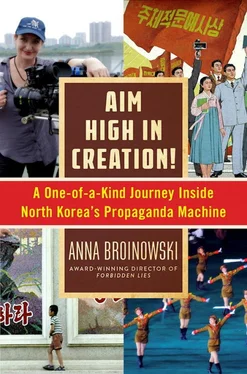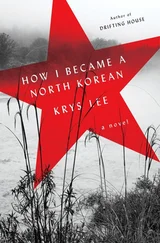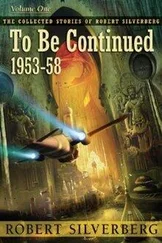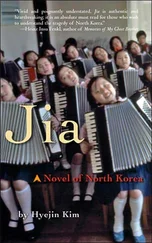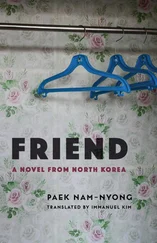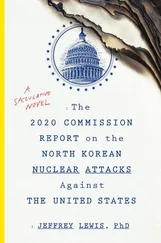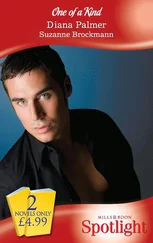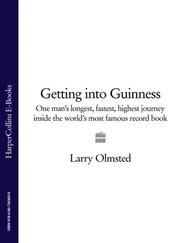“No way,” adds the waving Ms. Jang.
“Forget it,” giggles Mr. Pei.
“Oh God, her camera’s coming back again,” says Pak—and cracks an even bigger smile: “Hello, Australia! You’d better watch out! We may look happy to see Anna now, but…”
“Fantastic, thank you!” I call out, to Pak’s delight. “Cut!”
YOUR DEAR LEADER, BOB BROWN
“OMG,” I WHISPER TO NIC AS the man in the grey safari suit runs into the bushes with our passports.
Sun Hi, who is proving to be a keen student of Western slang, wants to know what the acronym means. “Oh my God,” I explain, giving her a crash course in texting shorthand. “There’s also ROFL—rolling around on the floor laughing—and if something is really funny, you ROFLMFAO—which means you roll around on the floor laughing your arse off.” I leave out the “fucking”—Sun Hi looks virginal enough to be offended.
“ROFLMFAO,” Sun Hi parrots happily, rolling the letters on her tongue. Then she grins: “Right back atcha, honey!” That’s something I said to Nic when we were packing up after yesterday’s shoot. Sun Hi, who is wearing the pink koala cap we gave her with a No Gas pin stuck proudly on the top, learns fast. “We are Team Gas!” she exclaims, and Mr. Wang and Q, who’ve attached No Gas pins to their lapels, nod supportively.
“Soon we will arrive at the April 25 Military Film Studio,” says Ms. K, ignoring my anxiety about our passport-less state. “April 25 is the auspicious day our Supreme Generalissimo Kim Il Sung led the glorious People’s Uprising on Jeju Island against the imperialist Japs. You must only film inside. No filming out the window. At all.”
I nod, trying to block out the images of the language teachers, computer programmers, engineers, and other experts North Korea has kidnapped over the decades to upskill its people. I’m not keen to emulate the career paths of superstar South Korean filmmakers Shin Sang Ok and Choi Eun Hee, whom Kim Jong Il kept in the gulags until they agreed to work for him. Then again, as a jobbing documentary maker from Erskineville, I’m hardly glamorous enough to kidnap. Comforted by this thought, I focus on our shoot.
The April 25 Military Film Studio has none of the laid-back outdoorsiness of the Pyongyang Film Studio. The treeless concrete bunker is accessed by an imposing road barred from the public by a gate with a red star. A gun-toting guard scans a document Ms. K shows him and slides the gate back on rusting wheels. We drive up to the steps of the building, where the Man in Black is waiting with a clipboard. He barks angrily at Ms. K: we are exactly six and a half minutes late. The April 25 Military Film Studio only makes war movies, using an arsenal of real planes, tanks, battleships, and bombs to create epic battle scenes, all shot in camera. Judging from the way Ms. K is begging the Man in Black’s forgiveness, it’s clear this place runs its shoots—and everything else it does—with uncompromising military precision.
I apologise profusely, and the Man in Black ignores me and marches inside. We hurry after him down the usual gloomy corridors. It may be sunny outside, but inside this building—like everywhere else we’ve been—it’s permanent twilight. We stop at the metal door of a large soundstage, without the On Air light you’d normally see in the West. The Man in Black slides the door open without knocking. In the middle of the studio is a softly glowing wooden hut, where a film shoot is in full swing. A beautiful young actress kneels in a tatami-mat room, speaking quietly to an autocratic, cross-legged man. Nic and I instinctively freeze: when you’re in an enclosed space like this, the slightest sound can ruin a good take. But Mr. Wang and Q walk up to the hut, bang our boxes down on the porch, and unpack the gear. Then I remember—they’re not recording sound.
“Cut!” calls an avuncular man in a porkpie hat, standing up from his camera to be introduced. Mr. O is the brilliant cinematographer of the most haunting North Korean movie I’ve seen, A Broad Bellflower . Mr. O and his director greet us warmly, their dark suits and ties the only things distinguishing them from their more-casual Pyongyang Film Studio colleagues. Q, Sun Hi, and Mr. Wang take off their shoes to climb inside the hut, and Nic and I follow suit. This is not for sound reasons: all Koreans remove their shoes before entering a house—even a fake one. The custom is as ancient as it is practical: it prevents dirt from getting in, and in this case, it protects the delicate tatami matting on the floor.
Mr. O is using a battered but lovingly maintained Arri 435 camera, with one assistant, one gaffer, and a focus puller. Everyone wears gloves. There are no metal light stands: the gaffer is angling the diffuser—a circle of opaque silk tacked to a thin wooden frame—by hand. The gaffer peers curiously at our Western version, a collapsible disc of space-age metallic fabric, which Q unfurls with quiet pride. We train our lens on the young actress, and I gasp at how she lights up the frame. Mr. O’s minimal lighting suddenly makes sense: this woman is a human light bulb. She has the luminosity of a young Meryl Streep: an inner glow only the rarest actresses possess.
“Action!” calls the director, and the old actor looks at the woman firmly: “You must, in good conscience, live up to the expectations of the Party and work where the Party needs you,” he says, and the director stops him immediately: “Don’t lecture her. She hasn’t done anything wrong. You’re just being supportive of your daughter. Say it gently: ‘You must be the patriot the fatherland expects you to be,’ that kind of thing, but with affection.” This simple direction transforms the propaganda into a touching scene of fatherly love. The actor repeats his take, and the young woman gives him a look of exquisite devotion. Mr. O looks up from his eyepiece: “That was terrific!” he says, beaming and flashing a row of gold-capped teeth.
Watching the woman’s close-ups spool back in the April 25 Military Film Studio screening room, I feel like I’ve been teleported back to 1935. The only sound in the theatre is the nostalgic whirr of the projector, operated with grim authority by a soldier straight out of a Riefenstahl movie: short-haired and high-cheeked, with a dramatic slick of vermilion on her austere mouth. “It would be nice to have the sound of waves over that shot,” muses Mr. O to the director, as dreamlike images of the actress and her father spool back in the muted dark: planting trees with soldiers, pointing binoculars at the misty sea, reading sepia books by Kim Jong Il on guano-spattered cliffs.
“What is your movie about?” I ask the director as the projectionist threads the next reel.
“The commander of a guardhouse, who protects an island in the East Sea,” he replies. “We’re making it so the commander can be a role model for the whole army. He’s been admiring our General his whole life, from this remote island. He’s determined to guard it until death.” The projector cranks back to life and a magnificent seascape appears, drifting over choppy waves towards the desolate island.
“It is also about isolation,” Mr. O says simply, confirming what I’ve sensed about him. Despite the propaganda he shoots, and his outwardly jolly manner, Mr. O has the soul of an artist—dedicated to capturing the pain and complexity of what it is to be human. A Broad Bellflower , when the Dear Leader speeches are removed, is extraordinary.
“Does the commander have an enemy?” I ask the filmmakers, wondering if their movie is being made in response to the naval military exercises that South Korea and its American allies conduct every year, just off North Korea’s coast. “No,” says the director, looking at our camera. “Although we are faced with the enemy in real situations, our movie does not show them. It just shows the lives of the soldiers guarding the island. There is a real dimension to it, in that we are under threat of the Americans attacking us. But our film is not about the actions we will take in response to their military exercises. It simply celebrates the determination of the soldiers to achieve battle-readiness.”
Читать дальше
